d46c946367aee6ddfdff3fa0e5181349.ppt
- Количество слайдов: 183


Chapter Introduction Section 1 The Republicans Take Power Section 2 The Louisiana Purchase Section 3 A Time of Conflict Section 4 The War of 1812 Chapter Summary Chapter Assessment Click on a hyperlink to view the corresponding slides.

Click the Speaker button to replay the audio.

Chapter Objectives Section 1: The Republicans Take Power • Discuss how the election of 1800 was resolved. • Explain how the Supreme Court was strengthened. Click the mouse button or press the Space Bar to display the information.

Chapter Objectives Section 2: The Louisiana Purchase • Discuss how the United States expanded in the early 1800 s. • Review the expeditions of explorers such as Lewis and Clark. Click the mouse button or press the Space Bar to display the information.

Chapter Objectives Section 3: A Time of Conflict • Explain why Tecumseh built a Native American confederacy. • Discuss why the War Hawks wanted to go to war. Click the mouse button or press the Space Bar to display the information.

Chapter Objectives Section 4: The War of 1812 • Describe how the British seized and set fire to Washington, D. C. • Explain why Andrew Jackson fought a battle after the war was over. Click the mouse button or press the Space Bar to display the information.

Why It Matters In 1801 the Democratic-Republican Party took control of the nation’s government. The Federalists–the party of Alexander Hamilton and John Adams–were now on the sidelines and played the role of critics to the Republican administration.

The Impact Today Politicians today operate within the party system that took shape at that time. • While the two main parties have changed, each still worked to win votes and gain power. • If the people vote to change the party in power, the newly elected representatives take office peacefully and the government continues. Click the mouse button or press the Space Bar to display the information.




Guide to Reading Main Idea The election of 1800 marked the transfer of power from one political party to another through a democratic election. Key Terms • laissez-faire • customs duties • judicial review Click the mouse button or press the Space Bar to display the information.

Guide to Reading (cont. ) Reading Strategy Organizing Information As you read the section, use a diagram like the one shown on page 278 of your textbook to identify ways Republicans tried to reduce the role of government. Read to Learn • how the election deadlock of 1800 was resolved. • how John Marshall strengthened the Supreme Court. Click the mouse button or press the Space Bar to display the information.

Guide to Reading (cont. ) Section Theme Government and Democracy Jefferson believed that a large federal government threatened liberty.

Abigail Adams in the unfinished White House Click the Speaker button to replay the audio.

The Election of 1800 • The election campaign of 1800 between Adams/Pinckney and Jefferson/Burr was very different from those of today. • Candidates and their friends wrote letters to leading citizens and newspapers to spread their views. • The Federalists and Republicans fought a bitter letter-writing campaign. (pages 278– 279) Click the mouse button or press the Space Bar to display the information.

The Election of 1800 (cont. ) • The election was deadlocked. • Both Jefferson and Burr received 73 electoral votes, so the House of Representatives had to decide the election. - The Federalists decided to support Burr to prevent the election of Jefferson. - Hamilton distrusted Burr but was not a friend of Jefferson either. - Finally, at Hamilton’s request, one Federalist voted against Burr, and Jefferson became president and Burr vice president. (pages 278– 279) Click the mouse button or press the Space Bar to display the information.

The Election of 1800 (cont. ) • To avoid another election deadlock, Congress passed the Twelfth Amendment in 1803. • It required electors to vote for the president and vice president on separate ballots. (pages 278– 279) Click the mouse button or press the Space Bar to display the information.

The Election of 1800 (cont. ) • Thomas Jefferson was inaugurated on March 4, 1801. • In his Inaugural Address, Jefferson tried to close the gap between the political parties. • His goals included: - “a wise and frugal government” - “support of state governments in all their rights” (pages 278– 279) Click the mouse button or press the Space Bar to display the information.

The Election of 1800 (cont. ) • Jefferson was a proponent of states’ rights. • He believed strong states would best protect freedom and that a large federal government would threaten liberty. • He also believed in laissez-faire, a policy in which government plays a small role in the economic concerns of a country. (pages 278– 279) Click the mouse button or press the Space Bar to display the information.

The Election of 1800 (cont. ) Why were the election campaigns of Adams and Jefferson different from campaigns of today? In 1800 transportation was limited. The best way to reach a large group of constituents was through letter writing. (pages 278– 279) Click the mouse button or press the Space Bar to display the answer.

Jefferson’s Policies • Jefferson surrounded himself with men who shared his Republican principles. • His cabinet had James Madison as secretary of state and Albert Gallatin as secretary of the treasury. • Under Jefferson the government allowed the unpopular Alien and Sedition Acts to expire and repealed the Naturalization Act. (page 280) Click the mouse button or press the Space Bar to display the information.

Jefferson’s Policies (cont. ) • Jefferson and Gallatin reduced the huge national debt. • They cut back on military expenses by reducing the size of the army and navy. • Jefferson and Gallatin also persuaded Congress to repeal federal internal taxes, including the whiskey tax. • The government funds would come from customs duties, or taxes on imported goods, and from the sale of Western lands. (page 280) Click the mouse button or press the Space Bar to display the information.

Jefferson’s Policies (cont. ) • The number of federal government employees was small under Jefferson. • He believed that the responsibility of government should be limited to delivering the mail, collecting customs duties, and conducting a census every 10 years. (page 280) Click the mouse button or press the Space Bar to display the information.

Jefferson’s Policies (cont. ) Jefferson was a wealthy landowner and a slaveholder, although he believed in individual freedoms. He was also an excellent practical politician. Do you think that his views of government would have been different had he not been wealthy? Possible answer: Jefferson did not let his wealth interfere with his principles. Jefferson cared about people. (page 280) Click the mouse button or press the Space Bar to display the answer.

Jefferson and the Courts • The Federalists controlled the court system even though Jefferson was a Republican. • The Federalists passed the Judiciary Act of 1801 before Jefferson took office. • Prior to leaving office, Adams made hundreds of appointments to the courts. • He also appointed John Marshall, his secretary of state, as chief justice of the United States after Chief Justice Ellsworth resigned. (pages 280– 281) Click the mouse button or press the Space Bar to display the information.

Jefferson and the Courts (cont. ) • Adams and Marshall worked around the clock to process the papers (commissions) for these last-minute “midnight judges. ” • A few of the commissions had not been processed when Jefferson took office on March 4. • Jefferson told Madison, his secretary of state, to hold them. • One of these was for William Marbury. (pages 280– 281) Click the mouse button or press the Space Bar to display the information.

Jefferson and the Courts (cont. ) • The Supreme Court heard the case of Marbury v. Madison. • Marbury went right to the Supreme Court to force delivery of his commission. • Marbury claimed that he had jurisdiction as a result of the Judiciary Act of 1789. • Marshall turned down his claim. (pages 280– 281) Click the mouse button or press the Space Bar to display the information.

Jefferson and the Courts (cont. ) • Marshall said that the Constitution did not give the Supreme Court jurisdiction to decide Marbury’s case. - This was the first time that judicial review was used. - Judicial review is the right of the Supreme Court to review and rule on acts of other branches of government. - Today judicial review is a basic part of our government and is a way to check and balance the other branches of the government. (pages 280– 281) Click the mouse button or press the Space Bar to display the information.

Jefferson and the Courts (cont. ) • Under Justice Marshall, who served as chief justice until 1835, the Supreme Court became an equal partner in government due to judicial review. • Under Marshall the court usually upheld the power of the national government over the rights of states. • The Marshall court used many Federalist beliefs in the American system of government. (pages 280– 281) Click the mouse button or press the Space Bar to display the information.

Jefferson and the Courts (cont. ) Why did John Adams make so many judicial appointments in the final hours of his presidency? Adams, along with Chief Justice Marshall, attempted to process the commissions for judicial appointments until the final hours so that the court system would be full of “Federalist thinking” judges when Jefferson took office. Adams did not win the presidency, but he did have a large impact on the courts. Presidents through history have made an impact as well by their Supreme Court appointments because justices serve for life or until they are too ill to serve the country. (pages 280– 281) Click the mouse button or press the Space Bar to display the answer.

Checking for Understanding Define Match the terms on the right with their definitions on the left. __ 1. the right of the Supreme C Court to determine if a law violates the Constitution A. laissez-faire __ 2. policy that government A should interfere as little as possible in the nation’s economy C. judicial review __ 3. taxes on foreign imported B goods Click the mouse button or press the Space Bar to display the answers. B. customs duties

Checking for Understanding Reviewing Facts Explain how Jefferson cut government spending. He cut the size of the army and navy, reduced the national debt, and kept the number of government workers low. Click the mouse button or press the Space Bar to display the answer.

Reviewing Themes Government and Democracy How did the judicial branch under Jefferson serve as a check on the executive and legislative branches? With the establishment of judicial review, the Supreme Court could review and rule on acts of the other branches of government. Click the mouse button or press the Space Bar to display the answer.

Critical Thinking Identifying Central Issues How was the deadlock in the presidential election of 1800 finally resolved? The House of Representatives decided the election. Hamilton swayed the vote in Jefferson’s favor. Click the mouse button or press the Space Bar to display the answer.

Analyzing Visuals Analyzing Architecture Examine the photograph of Monticello on page 279 of your textbook. Who lived there? What do you think gives Monticello its unique look? Explain. Thomas Jefferson lived at Monticello. Click the mouse button or press the Space Bar to display the answer.

Expository Writing A letter of recommendation is written to discuss the positive qualities of a person. Write a letter from John Adams to Thomas Jefferson about John Marshall. Address Marshall’s skills and leadership qualities.


Guide to Reading Main Idea The Louisiana Purchase opened a vast area to exploration and settlement. Key Terms • Conestoga wagon • secede Click the mouse button or press the Space Bar to display the information.

Guide to Reading (cont. ) Reading Strategy Classifying Information As you read, re-create the diagram on page 282 of your textbook and describe the areas that Lewis and Clark, and Zebulon Pike explored. Read to Learn • how the United States expanded in the early 1800 s. • how Lewis and Clark led an expedition to explore the Louisiana Territory. Click the mouse button or press the Space Bar to display the information.

Guide to Reading (cont. ) Section Theme Geography and History The purchase of the Louisiana Territory doubled the nation’s size.

Conestoga wagon Click the Speaker button to replay the audio.

Western Territory • Settlers in the less settled areas of the Northwest Territory and in Kentucky and Tennessee were pioneers. • They loaded their belongings onto Conestoga wagons and made the long, tiring journey over the Appalachian Mountains to the area west of the Mississippi River known as the Louisiana Territory. - The Louisiana Territory, a large area, belonged to Spain. - The region extended from New Orleans in the (pages 282– 283) south, west to the Rocky Mountains. Click the mouse button or press the Space Bar to display the information.

Western Territory (cont. ) - It was undefined to the north. - Many pioneers settled near the rivers that fed into the upper Mississippi River. - The Spanish allowed them to sail on the lower Mississippi and trade in New Orleans. - This access allowed farmers to unload goods in New Orleans and then ship these goods to markets in the East. (pages 282– 283) Click the mouse button or press the Space Bar to display the information.

Western Territory (cont. ) • In 1802 Spain changed its policy and refused to allow American goods to move into or past New Orleans. • Jefferson confirmed that Spain had transferred the Louisiana Territory to France in a secret agreement. • The United States was surprised and fearful that Napoleon Bonaparte, France’s leader, wanted to increase his empire in Europe and the Americas. (pages 282– 283) Click the mouse button or press the Space Bar to display the information.

Western Territory (cont. ) • Jefferson authorized Robert Livingston, the new minister to France, to offer as much as $10 million for New Orleans and West Florida. (pages 282– 283)

Western Territory (cont. ) • Because of unrest in Santo Domingo (now Haiti and the Dominican Republic), Napoleon had to cancel his plans to create an empire in America. • He sent in troops to crush a revolt against French rule. • Toussaint-Louverture, a former enslaved African, led the revolt. • He helped drive the British and Spanish from the island end slavery there. • The French captured Toussaint-Louverture but did not regain the island. (pages 282– 283) Click the mouse button or press the Space Bar to display the information.

Western Territory (cont. ) Why was the Louisiana Territory important to Americans? It was a large area of land that provided space for settlers to begin a new life in the West. Because of its proximity to the Mississippi River, farmers had a way to transport their goods and make money from the markets in the East. When Spain, who owned the land, refused American access to or past the port of New Orleans, it became even more important for Americans to continue to have access to the territory and use the Mississippi River for (pages 282– 283) transport. Click the mouse button or press the Space Bar to display the answer.

The Nation Expands • America bought the Louisiana Territory from France. • The French needed money to finance Napoleon’s plans for war against Britain, so while the American diplomats were in France, Talleyrand informed them that the entire Louisiana Territory was for sale. • Monroe and Livingston negotiated a price of $15 million for the territory. • With this territory, the size of the United States doubled. (pages 283– 285) Click the mouse button or press the Space Bar to display the information.

The Nation Expands (cont. ) • The United States ratified the treaty with France in October 1803 to make the Louisiana Territory purchase legal. • Jefferson was concerned about the purchase because the Constitution said nothing about acquiring new territory. • Jefferson was interested in knowing more about the lands west of the Mississippi River. (pages 283– 285) Click the mouse button or press the Space Bar to display the information.

The Nation Expands (cont. ) • Jefferson sent Meriwether Lewis and William Clark to explore the new territory even before the Louisiana Purchase was complete. - Jefferson saw the expedition as a scientific adventure, while Congress was interested in commercial possibilities and places for future ports. - Lewis and Clark put together a crew and left St. Louis in the spring of 1804. - Along the way they kept a journal of valuable information on the people, plants, animals, and geography of the West. (pages 283– 285) Click the mouse button or press the Space Bar to display the information.

The Nation Expands (cont. ) - After traveling nearly 4, 000 miles in 18 months, they reached the Pacific Ocean. - They spent the winter there and traveled back along different routes. • Jefferson sent another expedition to explore the wilderness. • Lieutenant Zebulon Pike led two expeditions into a region that is now Colorado. • There he found a snowcapped mountain he called Grand Peak. Today it is called Pikes Peak. (pages 283– 285) Click the mouse button or press the Space Bar to display the information.

The Nation Expands (cont. ) • A group of Federalists who opposed the Louisiana Purchase planned to secede, or withdraw, from the Union. • They were concerned that the new territory would become agricultural and Republican, and because it was so large, they would lose power. - They wanted to form a Northern Confederacy including New York. - To get the New York support, the Federalists supported Aaron Burr for governor of New York in 1804. (pages 283– 285) Click the mouse button or press the Space Bar to display the information.

The Nation Expands (cont. ) • Hamilton, who never trusted Burr, heard rumors that Burr had secretly agreed to lead New York out of the Union. • Burr lost the election and blamed Hamilton. - Burr challenged Hamilton to a duel with armed pistols. - It took place in July 1804 in Weehawken, New Jersey. - Hamilton abhorred dueling and pledged not to shoot. (pages 283– 285) Click the mouse button or press the Space Bar to display the information.

The Nation Expands (cont. ) - Burr, on the other hand, fired and seriously wounded Hamilton, who died the next day. - Burr fled so he would not be jailed. (pages 283– 285) Click the mouse button or press the Space Bar to display the information.

The Nation Expands (cont. ) What was so valuable about the Lewis and Clark expedition and the other expeditions to the West? Since the nation had little knowledge of the lands west of the Mississippi, Jefferson wanted to be able to provide information for people who were looking to move west. By sponsoring government expeditions, Jefferson hoped to gain knowledge for new settlers about the land, the climate, the wildlife, and the geography. Lewis and Clark’s journal kept detailed records, including maps of their travels, to prepare people who wanted to move west. Sending men into the wilderness and seeing them return also offered hope and inspiration to Americans who had desires to move west. (pages 283– 285) Click the mouse button or press the Space Bar to display the answer.

Checking for Understanding Define Match the terms on the right with their definitions on the left. __ 1. to leave or withdraw B __ 2. sturdy vehicle topped with A white canvas and used by pioneers to move west Click the mouse button or press the Space Bar to display the answers. A. Conestoga wagon B. secede

Checking for Understanding Reviewing Facts What European countries controlled the Louisiana Territory up until 1800? Spain controlled the Louisiana Territory up until 1800. Click the mouse button or press the Space Bar to display the answer.

Reviewing Themes Geography and History Why were the Mississippi River and New Orleans important to the United States? Farmers needed to ship their goods down the Mississippi River to New Orleans to get them to markets. Click the mouse button or press the Space Bar to display the answer.
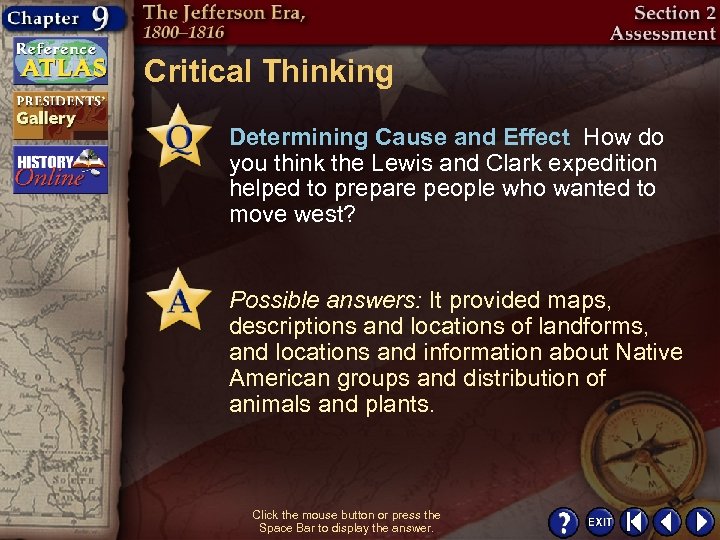
Critical Thinking Determining Cause and Effect How do you think the Lewis and Clark expedition helped to prepare people who wanted to move west? Possible answers: It provided maps, descriptions and locations of landforms, and locations and information about Native American groups and distribution of animals and plants. Click the mouse button or press the Space Bar to display the answer.

Analyzing Visuals Geography Skills Review the map on page 284 of your textbook. What was the farthest western point that the Lewis and Clark expedition reached? What is the straight-line distance between St. Louis and Pikes Peak? The Lewis and Clark expedition reached the Pacific Ocean. The distance is about 775 miles (1, 250 km). Click the mouse button or press the Space Bar to display the answer.
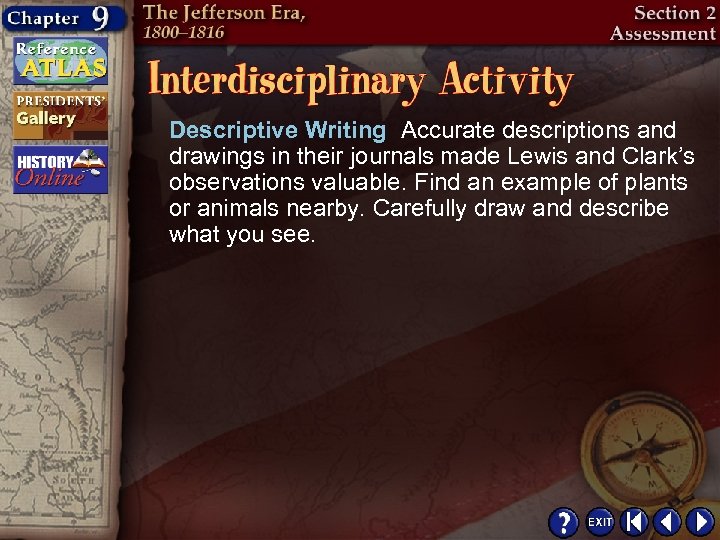
Descriptive Writing Accurate descriptions and drawings in their journals made Lewis and Clark’s observations valuable. Find an example of plants or animals nearby. Carefully draw and describe what you see.
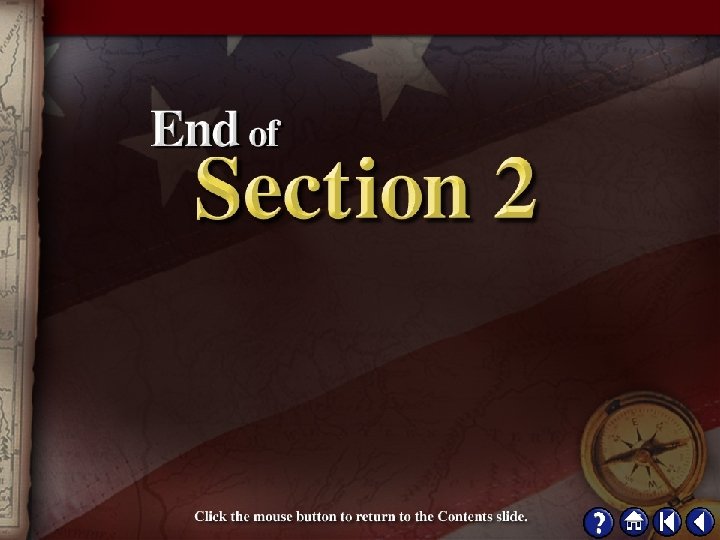

Guide to Reading Main Idea Between 1800 and 1815 the United States experienced rapid expansion as well as the challenge of war. Key Terms • tribute • embargo • neutral rights • War Hawks • impressment • nationalism Click the mouse button or press the Space Bar to display the information.
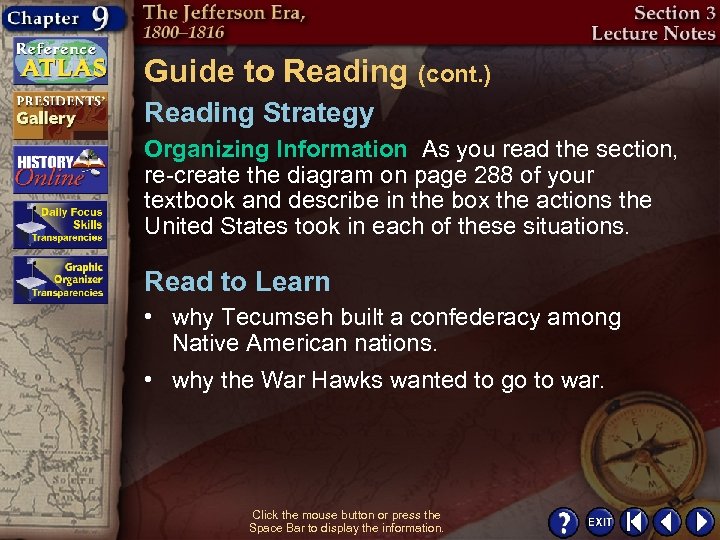
Guide to Reading (cont. ) Reading Strategy Organizing Information As you read the section, re-create the diagram on page 288 of your textbook and describe in the box the actions the United States took in each of these situations. Read to Learn • why Tecumseh built a confederacy among Native American nations. • why the War Hawks wanted to go to war. Click the mouse button or press the Space Bar to display the information.

Guide to Reading (cont. ) Section Theme Global Connections The nation’s neutrality was challenged.
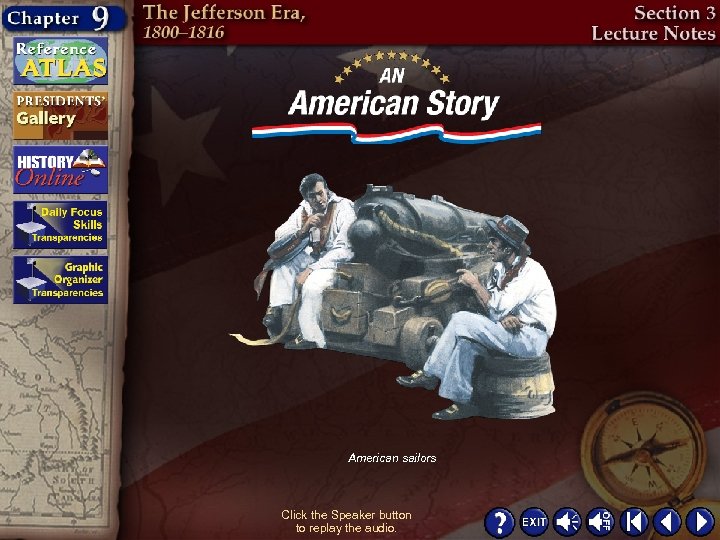
American sailors Click the Speaker button to replay the audio.

Americans in Foreign Seas • Many American merchant ships profited from trade with foreign nations in the late 1700 s and early 1800 s. • Ships made calls in South America, Africa, and along the Mediterranean Sea. • By 1800 the United States had almost 1, 000 ships trading around the world. (pages 288– 289) Click the mouse button or press the Space Bar to display the information.

Americans in Foreign Seas (cont. ) • Sailing foreign waters could be dangerous, however. • Ships had to watch for Barbary pirates from Tripoli and other Barbary Coast states of North Africa. • These pirates demanded tribute, or protection money, to let ships safely pass the Mediterranean waters. (pages 288– 289) Click the mouse button or press the Space Bar to display the information.

Americans in Foreign Seas (cont. ) • The United States entered a war with Tripoli. • When the ruler of Tripoli asked the United States for more money in 1801, Jefferson refused. • War broke out. Jefferson sent ships to blockade Tripoli, but the Barbary pirates were too powerful to be defeated. (pages 288– 289) Click the mouse button or press the Space Bar to display the information.
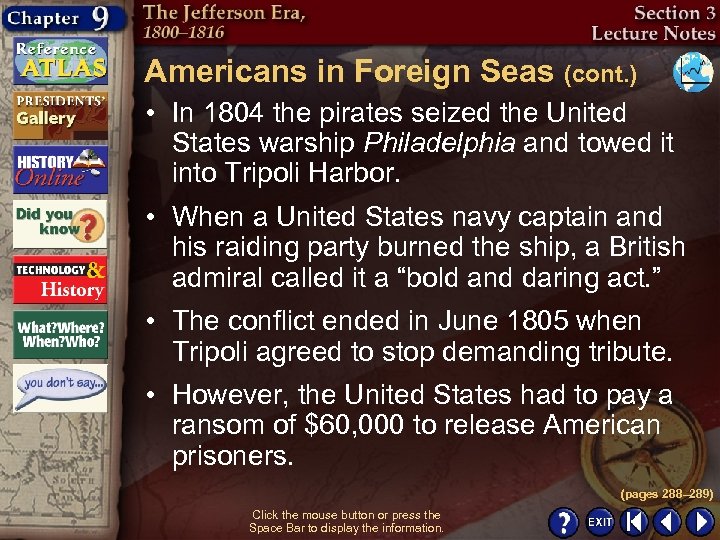
Americans in Foreign Seas (cont. ) • In 1804 the pirates seized the United States warship Philadelphia and towed it into Tripoli Harbor. • When a United States navy captain and his raiding party burned the ship, a British admiral called it a “bold and daring act. ” • The conflict ended in June 1805 when Tripoli agreed to stop demanding tribute. • However, the United States had to pay a ransom of $60, 000 to release American prisoners. (pages 288– 289) Click the mouse button or press the Space Bar to display the information.
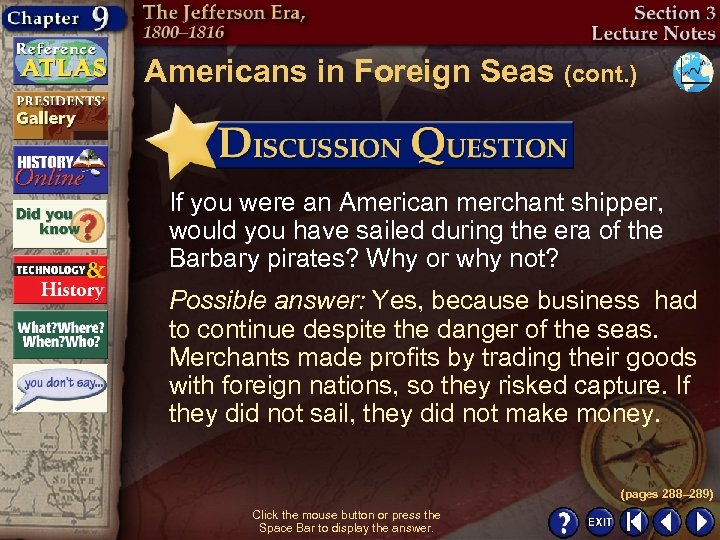
Americans in Foreign Seas (cont. ) If you were an American merchant shipper, would you have sailed during the era of the Barbary pirates? Why or why not? Possible answer: Yes, because business had to continue despite the danger of the seas. Merchants made profits by trading their goods with foreign nations, so they risked capture. If they did not sail, they did not make money. (pages 288– 289) Click the mouse button or press the Space Bar to display the answer.

Freedom of the Seas • Great Britain and France were involved in a war that threatened to interfere with American trade. • America traded with both Britain and France when the two countries went to war in 1803. • For two years American shipping had neutral rights, or the right to sail the seas because it did not side with either country. (pages 290– 291) Click the mouse button or press the Space Bar to display the information.
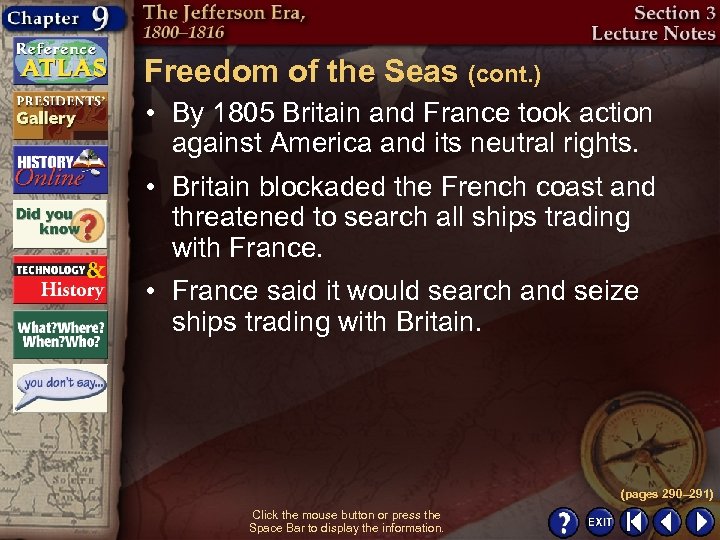
Freedom of the Seas (cont. ) • By 1805 Britain and France took action against America and its neutral rights. • Britain blockaded the French coast and threatened to search all ships trading with France. • France said it would search and seize ships trading with Britain. (pages 290– 291) Click the mouse button or press the Space Bar to display the information.
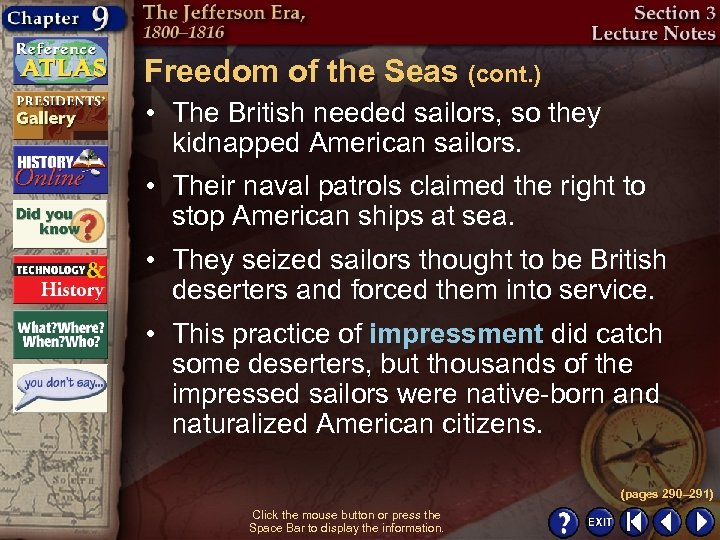
Freedom of the Seas (cont. ) • The British needed sailors, so they kidnapped American sailors. • Their naval patrols claimed the right to stop American ships at sea. • They seized sailors thought to be British deserters and forced them into service. • This practice of impressment did catch some deserters, but thousands of the impressed sailors were native-born and naturalized American citizens. (pages 290– 291) Click the mouse button or press the Space Bar to display the information.

Freedom of the Seas (cont. ) • The British attacked the American ship Chesapeake in June 1807. • The British warship Leopard intercepted the Chesapeake and demanded to search the ship for British deserters. • The British opened fire when the Chesapeake’s captain refused to let the British search his ship. • Americans were furious at the British when they heard of the attack. • Many demanded war. (pages 290– 291) Click the mouse button or press the Space Bar to display the information.

Freedom of the Seas (cont. ) • However, Jefferson chose another path. • Congress passed a disastrous trade ban in December 1807 called the Embargo Act. • The hope was to hurt Britain. • Instead, the embargo banned imports from and exports to all foreign countries. - The act was a disaster. - It wiped out all American commerce with other nations. - It was also ineffective against Britain because Britain traded with Latin America for agricultural goods. (pages 290– 291) Click the mouse button or press the Space Bar to display the information.
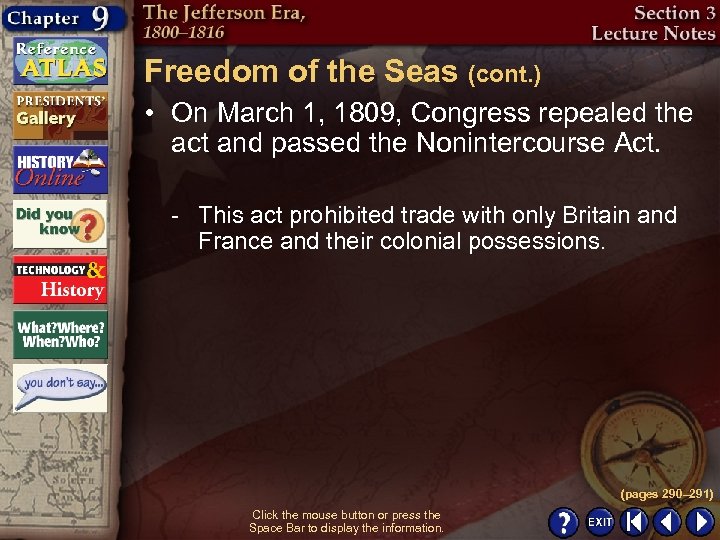
Freedom of the Seas (cont. ) • On March 1, 1809, Congress repealed the act and passed the Nonintercourse Act. - This act prohibited trade with only Britain and France and their colonial possessions. (pages 290– 291) Click the mouse button or press the Space Bar to display the information.

Freedom of the Seas (cont. ) • Jefferson announced his departure after two terms. • The candidates nominated were Madison for the Republicans and Pinckney for the Federalists. • Madison with 122 electoral votes to Pinckney’s 47. (pages 290– 291) Click the mouse button or press the Space Bar to display the information.

Freedom of the Seas (cont. ) Why was the Embargo Act such a disaster? It killed American commerce by banning imports from and exports to all foreign countries, and it did not hurt Britain, which was the true target. Congress realized its mistake and repealed the act, though probably too late. (pages 290– 291) Click the mouse button or press the Space Bar to display the answer.

War Fever • When James Madison took office, the country was suffering from the embargo crisis and the possibility of war. • The war cry grew close, but it was hard to determine if the enemy was France or Britain. • In 1810 Congress passed a law permitting direct trade with either France or Britain. • Because France lifted its trade restrictions first, Americans were able to trade directly with France. (pages 291– 294) Click the mouse button or press the Space Bar to display the information.

War Fever (cont. ) • Napoleon, however, tricked the United States and continued to seize ships. • Madison still saw Britain as the larger threat to the United States, despite Napoleon’s actions. • The country also had problems in the West. (pages 291– 294) Click the mouse button or press the Space Bar to display the information.

War Fever (cont. ) • Between 1801 and 1810, white settlers continued to move onto lands that had been guaranteed to Native Americans. • Ohio became a state in 1803. • Native Americans renewed their associations with British agents and fur traders in Canada for protection. • Some Native Americans built a confederacy among their nations in the Northwest. • They were led by Tecumseh, a Shawnee chief. (pages 291– 294) Click the mouse button or press the Space Bar to display the information.
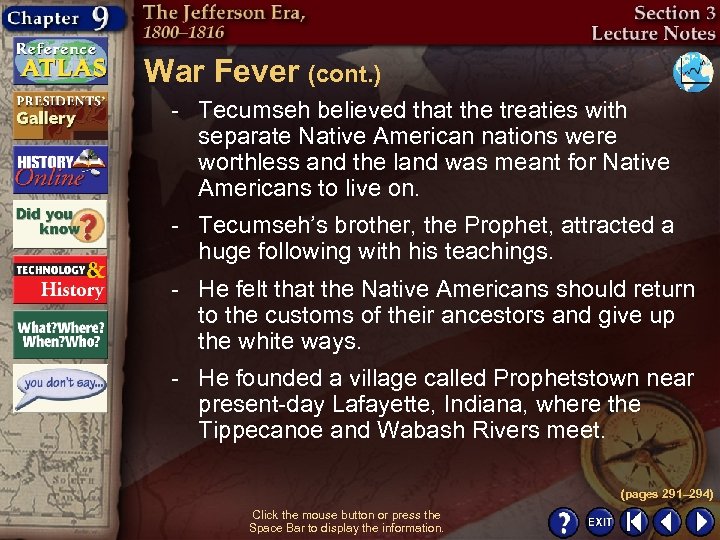
War Fever (cont. ) - Tecumseh believed that the treaties with separate Native American nations were worthless and the land was meant for Native Americans to live on. - Tecumseh’s brother, the Prophet, attracted a huge following with his teachings. - He felt that the Native Americans should return to the customs of their ancestors and give up the white ways. - He founded a village called Prophetstown near present-day Lafayette, Indiana, where the Tippecanoe and Wabash Rivers meet. (pages 291– 294) Click the mouse button or press the Space Bar to display the information.

War Fever (cont. ) • Tecumseh met with the white people and the governor of the Indiana Territory, General William Henry Harrison, after Harrison had warned him of the weakness of a Native American-British alliance and the power of the United States against them. • Tecumseh said that it was the Americans who were killing the Native Americans, taking away the land, pushing the Native Americans to do mischief, and keeping the tribes from uniting. (pages 291– 294) Click the mouse button or press the Space Bar to display the information.

War Fever (cont. ) • In 1811 Harrison attacked Prophetstown at the Battle of Tippecanoe. • The Americans proclaimed a victory, while the Prophet’s forces fled. • Unfortunately for the Americans, Tecumseh and the British forces united as a result of the American victory. (pages 291– 294) Click the mouse button or press the Space Bar to display the information.
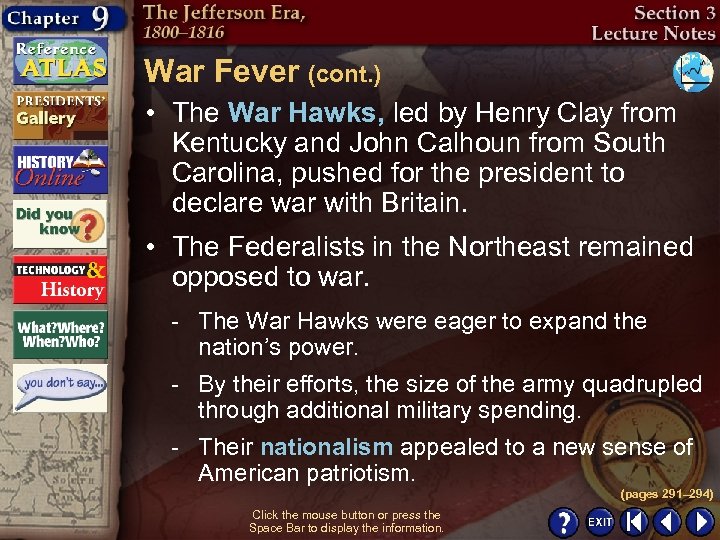
War Fever (cont. ) • The War Hawks, led by Henry Clay from Kentucky and John Calhoun from South Carolina, pushed for the president to declare war with Britain. • The Federalists in the Northeast remained opposed to war. - The War Hawks were eager to expand the nation’s power. - By their efforts, the size of the army quadrupled through additional military spending. - Their nationalism appealed to a new sense of American patriotism. (pages 291– 294) Click the mouse button or press the Space Bar to display the information.
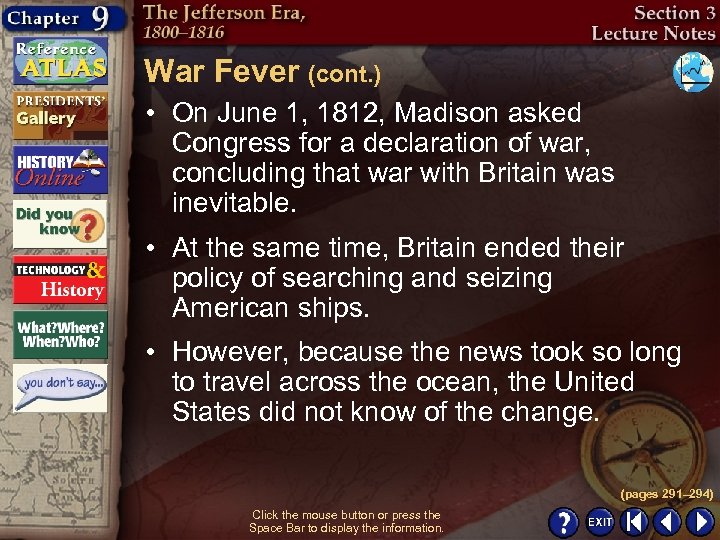
War Fever (cont. ) • On June 1, 1812, Madison asked Congress for a declaration of war, concluding that war with Britain was inevitable. • At the same time, Britain ended their policy of searching and seizing American ships. • However, because the news took so long to travel across the ocean, the United States did not know of the change. (pages 291– 294) Click the mouse button or press the Space Bar to display the information.

War Fever (cont. ) Why did Madison think that the enemy was Britain, not France, and that the war with Britain was inevitable? Madison did not trust the British in their alliance with the Native Americans. He sensed an anti-British feeling growing among Americans. Because Britain had once ruled the country and because of their powerful navy, Britain was a larger military threat to the United States than France was. Because Madison thought Britain was going to continue searching and seizing American ships, a war with Britain seemed about to happen. (pages 291– 294) Click the mouse button or press the Space Bar to display the answer.
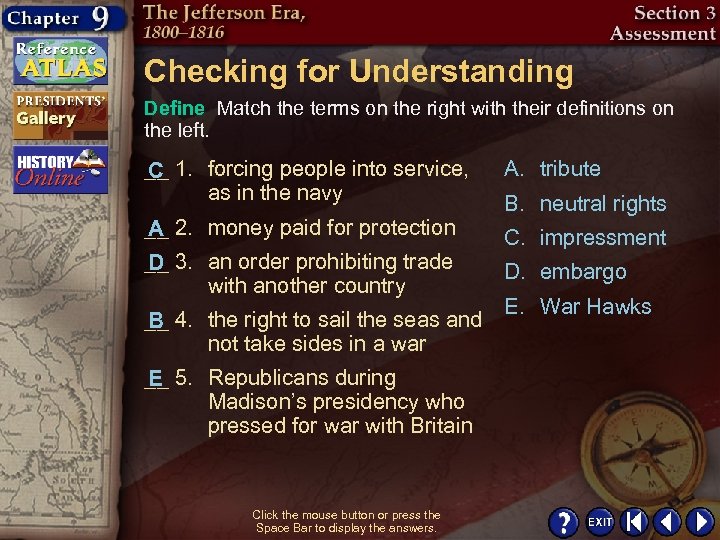
Checking for Understanding Define Match the terms on the right with their definitions on the left. __ 1. forcing people into service, C as in the navy A. tribute __ 2. money paid for protection A __ 3. an order prohibiting trade D with another country C. impressment __ 4. the right to sail the seas and B not take sides in a war __ 5. Republicans during E Madison’s presidency who pressed for war with Britain Click the mouse button or press the Space Bar to display the answers. B. neutral rights D. embargo E. War Hawks

Checking for Understanding Reviewing Facts Describe the negotiations that ended the war between the United States and Tripoli agreed to stop demanding tribute, but the United States had to pay a ransom for the release of American prisoners. Click the mouse button or press the Space Bar to display the answer.

Reviewing Themes Global Connections How did the conflict in Europe help the American shipping industry prosper? By remaining neutral, the United States could trade with both France and Britain. Both countries kept most of their trading ships in port to avoid capture, so Americans increased their trade. Click the mouse button or press the Space Bar to display the answer.

Critical Thinking Determining Cause and Effect How did frontier battles with Native Americans intensify Americans’ anti-British feelings? The British sided with Native Americans; this interference angered many Americans. Click the mouse button or press the Space Bar to display the answer.

Analyzing Visuals Geography Skills Examine the maps that appear on page 291 of your textbook. When did Tennessee gain statehood? Which of the maps shows the territory gained from the Louisiana Purchase? In what year was Florida ceded to the United States? Tennessee gained statehood in 1796. The 1810 map shows the territory gained from the Louisiana Purchase. Florida was ceded to the United States in 1819. Click the mouse button or press the Space Bar to display the answer.
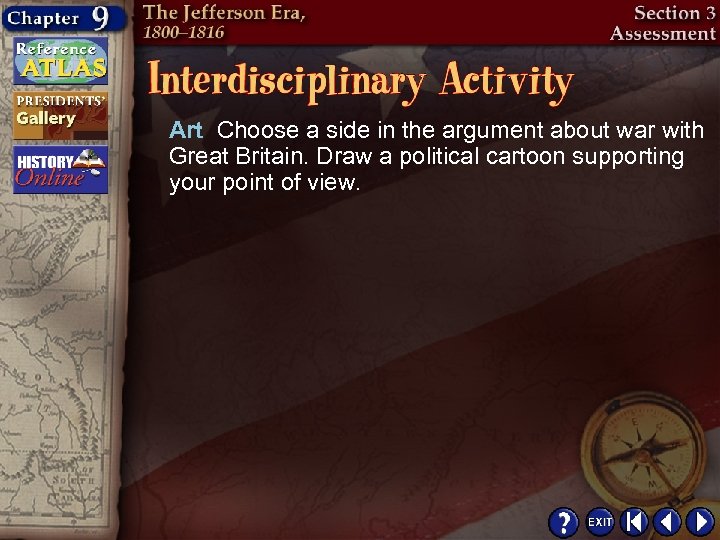
Art Choose a side in the argument about war with Great Britain. Draw a political cartoon supporting your point of view.


Guide to Reading Main Idea Beginning in 1812 the United States was at war with Britain. Fighting took place in the United States, in Canada, and at sea. Key Terms • frigate • privateer Click the mouse button or press the Space Bar to display the information.
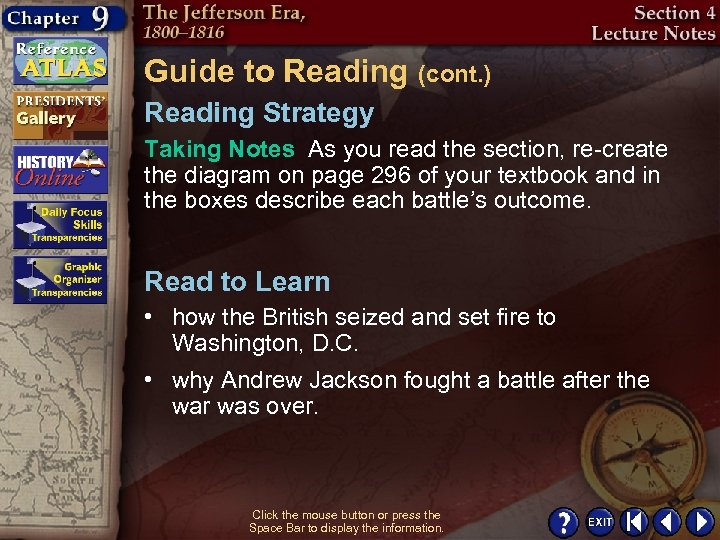
Guide to Reading (cont. ) Reading Strategy Taking Notes As you read the section, re-create the diagram on page 296 of your textbook and in the boxes describe each battle’s outcome. Read to Learn • how the British seized and set fire to Washington, D. C. • why Andrew Jackson fought a battle after the war was over. Click the mouse button or press the Space Bar to display the information.

Guide to Reading (cont. ) Section Theme Government and Democracy The end of the War of 1812 produced a new spirit of nationalism.
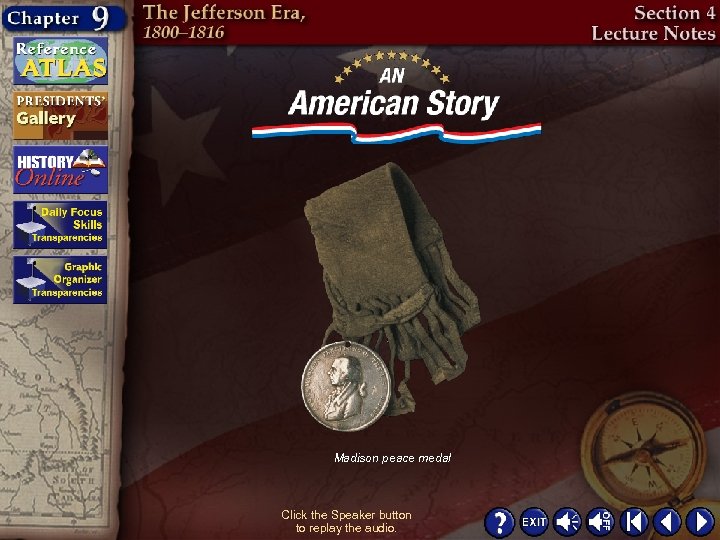
Madison peace medal Click the Speaker button to replay the audio.

War Begins • The United States was unprepared for the war. • It had a government that provided no leadership, a small army of 7, 000, and state militias with 50, 000 to 100, 000 poorly trained soldiers, some of whom were too old to fight. (pages 296– 298) Click the mouse button or press the Space Bar to display the information.
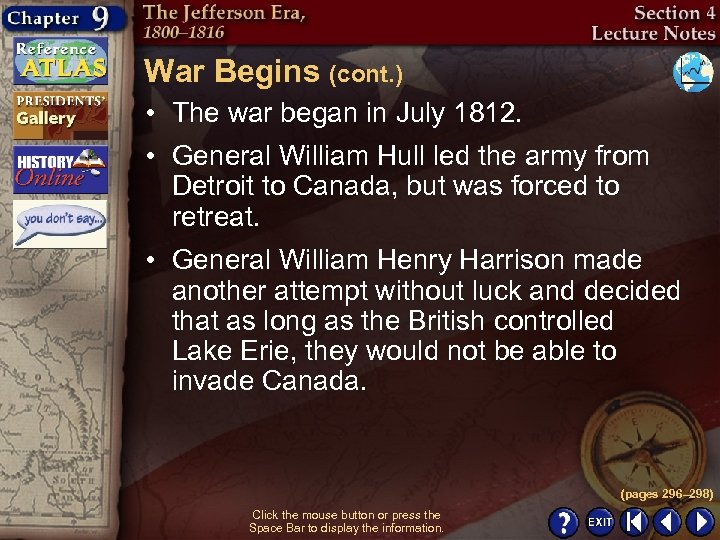
War Begins (cont. ) • The war began in July 1812. • General William Hull led the army from Detroit to Canada, but was forced to retreat. • General William Henry Harrison made another attempt without luck and decided that as long as the British controlled Lake Erie, they would not be able to invade Canada. (pages 296– 298) Click the mouse button or press the Space Bar to display the information.

War Begins (cont. ) • Naval battles were more successful. • The navy was more prepared with three of the fastest frigates, or warships. • On September 10, 1813, after a bloody battle along Lake Erie led by Oliver Hazard Perry, American ships destroyed the British naval force. (pages 296– 298) Click the mouse button or press the Space Bar to display the information.
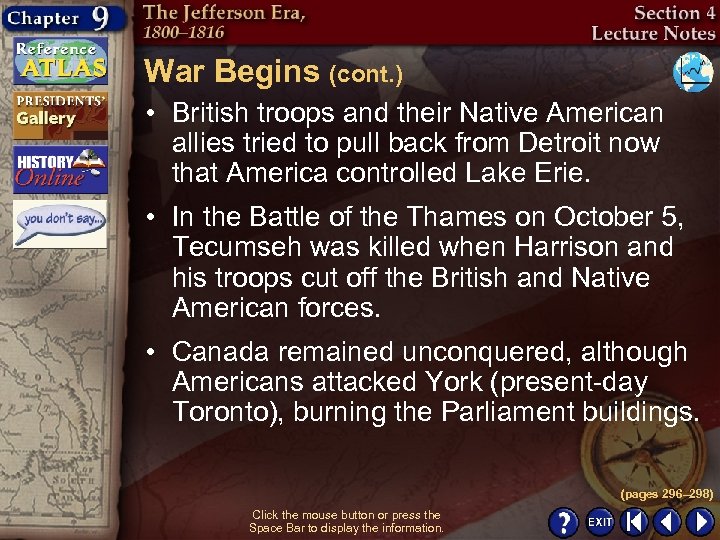
War Begins (cont. ) • British troops and their Native American allies tried to pull back from Detroit now that America controlled Lake Erie. • In the Battle of the Thames on October 5, Tecumseh was killed when Harrison and his troops cut off the British and Native American forces. • Canada remained unconquered, although Americans attacked York (present-day Toronto), burning the Parliament buildings. (pages 296– 298) Click the mouse button or press the Space Bar to display the information.

War Begins (cont. ) • The war at sea saw more victories. • In August 1812, the American warship Constitution destroyed a British vessel and four months later destroyed another British ship. • American privateers attacked and captured numerous vessels. (pages 296– 298) Click the mouse button or press the Space Bar to display the information.

War Begins (cont. ) • The Native Americans had some setbacks. • When Tecumseh died, hopes of a Native American confederation also died. • In March 1814, at the Battle of Horseshoe Bend, Jackson attacked and defeated the Creeks. • They were forced to give up most of their lands in the United States. (pages 296– 298) Click the mouse button or press the Space Bar to display the information.
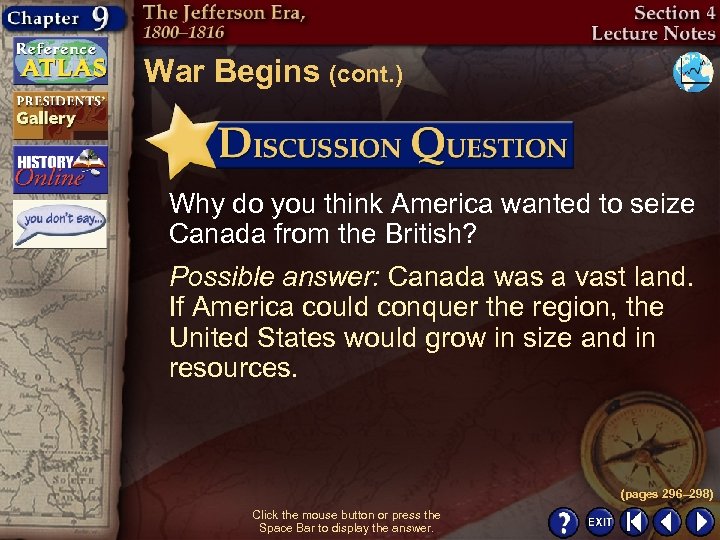
War Begins (cont. ) Why do you think America wanted to seize Canada from the British? Possible answer: Canada was a vast land. If America could conquer the region, the United States would grow in size and in resources. (pages 296– 298) Click the mouse button or press the Space Bar to display the answer.

The British Offensive • In the spring of 1814, the British won the war with the French. • Now they could send more troops to America. • In August 1814, the British marched into the capital of Washington, D. C. , burning and destroying the city. (pages 298– 300) Click the mouse button or press the Space Bar to display the information.
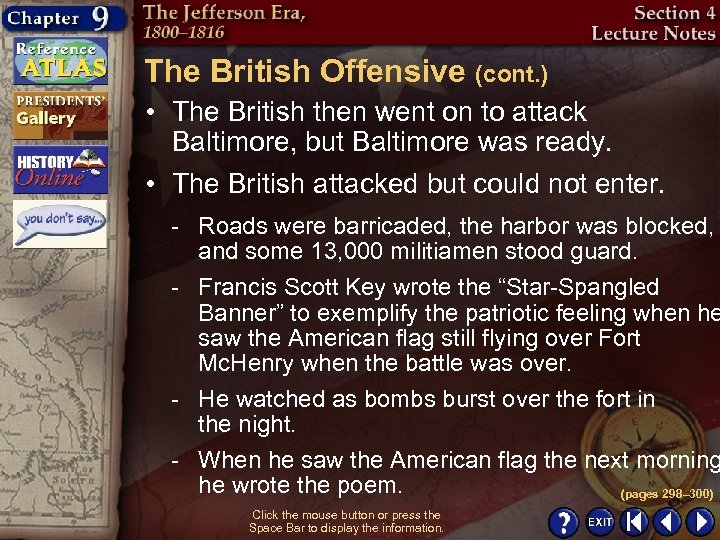
The British Offensive (cont. ) • The British then went on to attack Baltimore, but Baltimore was ready. • The British attacked but could not enter. - Roads were barricaded, the harbor was blocked, and some 13, 000 militiamen stood guard. - Francis Scott Key wrote the “Star-Spangled Banner” to exemplify the patriotic feeling when he saw the American flag still flying over Fort Mc. Henry when the battle was over. - He watched as bombs burst over the fort in the night. - When he saw the American flag the next morning he wrote the poem. (pages 298– 300) Click the mouse button or press the Space Bar to display the information.
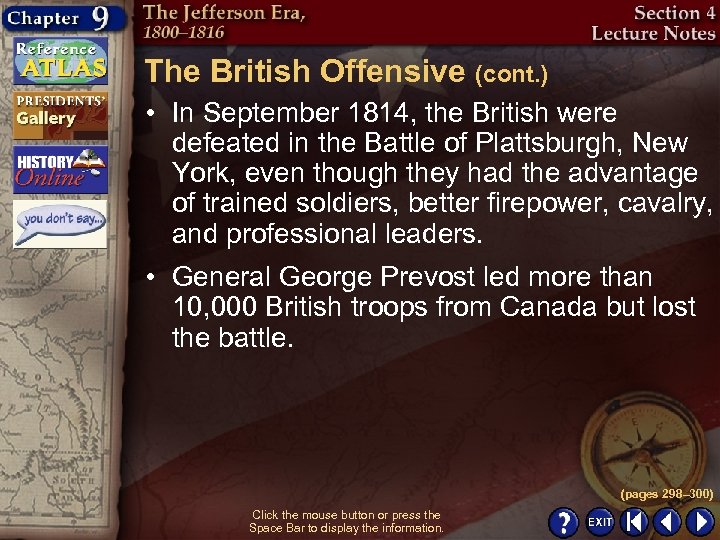
The British Offensive (cont. ) • In September 1814, the British were defeated in the Battle of Plattsburgh, New York, even though they had the advantage of trained soldiers, better firepower, cavalry, and professional leaders. • General George Prevost led more than 10, 000 British troops from Canada but lost the battle. (pages 298– 300) Click the mouse button or press the Space Bar to display the information.

The British Offensive (cont. ) • The British decided after the Plattsburgh loss that the war in North America was too costly and unnecessary. • In December 1814, in Ghent, Belgium, American and British representatives signed the Treaty of Ghent to end the war. • The treaty did not change any of the existing borders. (pages 298– 300) Click the mouse button or press the Space Bar to display the information.
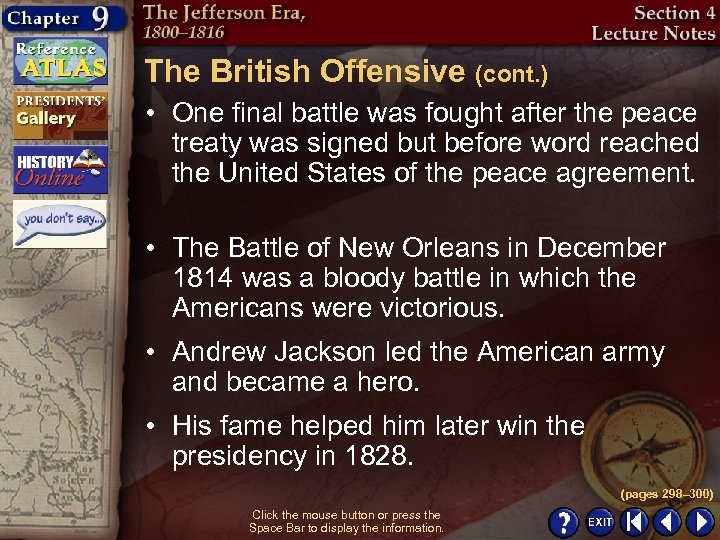
The British Offensive (cont. ) • One final battle was fought after the peace treaty was signed but before word reached the United States of the peace agreement. • The Battle of New Orleans in December 1814 was a bloody battle in which the Americans were victorious. • Andrew Jackson led the American army and became a hero. • His fame helped him later win the presidency in 1828. (pages 298– 300) Click the mouse button or press the Space Bar to display the information.
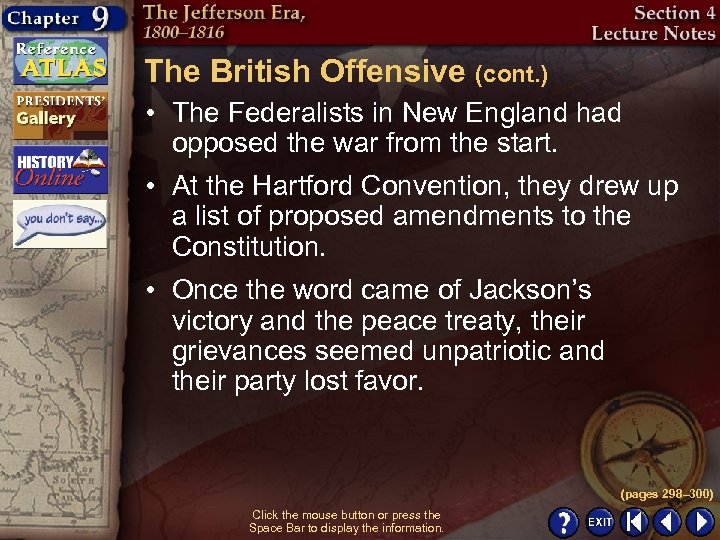
The British Offensive (cont. ) • The Federalists in New England had opposed the war from the start. • At the Hartford Convention, they drew up a list of proposed amendments to the Constitution. • Once the word came of Jackson’s victory and the peace treaty, their grievances seemed unpatriotic and their party lost favor. (pages 298– 300) Click the mouse button or press the Space Bar to display the information.

The British Offensive (cont. ) How did the War of 1812 affect the country? The American victory brought a spirit of nationalism. The War Hawks, who urged the president to declare war, were winners, too. People viewed members of the Republican Party with respect. Even the New England Federalists, who had opposed the war, felt a sense of patriotism. Americans felt that now Britain would see the United States as a political equal. America could now focus again on Western expansion, developing the economy, and creating a strong army and navy. (pages 298– 300) Click the mouse button or press the Space Bar to display the answer.

Checking for Understanding Define Match the terms on the right with their definitions on the left. __ 1. warship A __ 2. armed private ship B Click the mouse button or press the Space Bar to display the answers. A. frigate B. privateer
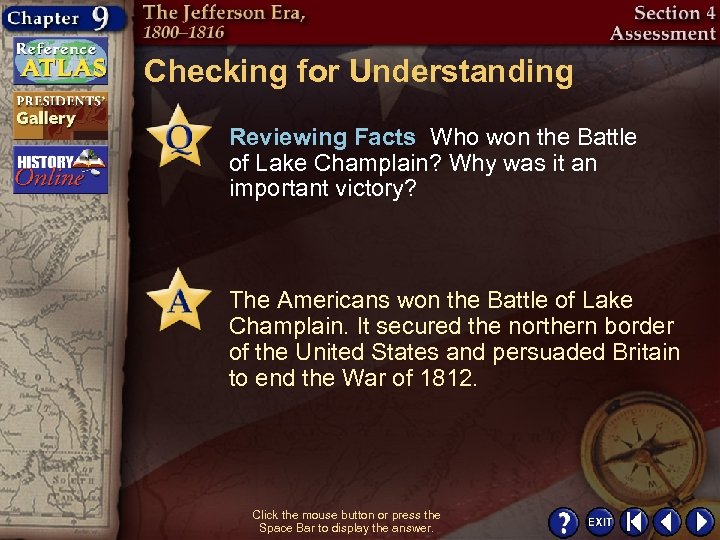
Checking for Understanding Reviewing Facts Who won the Battle of Lake Champlain? Why was it an important victory? The Americans won the Battle of Lake Champlain. It secured the northern border of the United States and persuaded Britain to end the War of 1812. Click the mouse button or press the Space Bar to display the answer.

Reviewing Themes Government and Democracy Why did the Federalist Party lose support after the War of 1812? It appeared unpatriotic because it had opposed the war and wanted to amend the Constitution. Click the mouse button or press the Space Bar to display the answer.

Critical Thinking Drawing Conclusions Why did people from the North, South, and the West feel differently about going to war with Britain? Possible answer: Westerners and Southerners thought war might make more land available and wanted to avenge British actions against Americans. Northerners saw little benefit in war. Click the mouse button or press the Space Bar to display the answer.

Analyzing Visuals Geography Skills Study the map on page 298 of your textbook. On what lake did Perry defeat the British? Which battle– Lake Champlain or Thames–took place later in time? Perry defeated the British on Lake Erie. The Battle of Lake Champlain took place later. Click the mouse button or press the Space Bar to display the answer.

Music Imagine if Francis Scott Key had been at the Battle of New Orleans instead of in Baltimore. Rewrite the first verse of “The Star-Spangled Banner” based on what occurred in that battle.


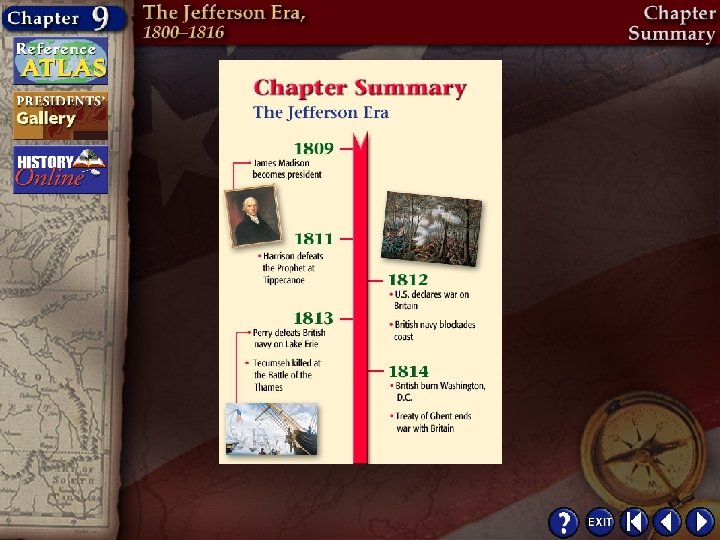


Reviewing Key Terms Define Match the terms on the right with their definitions on the left. __ 1. the right of the Supreme E Court to determine if a law violates the Constitution __ 2. forcing people into service, B as in the navy __ 3. loyalty to a nation and D promotion of its interests above all others __ 4. policy that government A should interfere as little as possible in the nation’s economy Click the mouse button or press the Space Bar to display the answers. A. laissez-faire B. impressment C. embargo D. nationalism E. judicial review F. secede
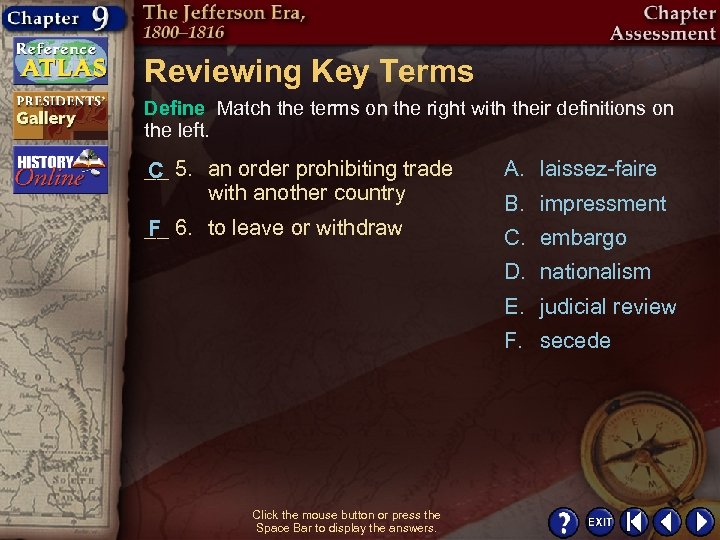
Reviewing Key Terms Define Match the terms on the right with their definitions on the left. __ 5. an order prohibiting trade C with another country A. laissez-faire __ 6. to leave or withdraw F C. embargo B. impressment D. nationalism E. judicial review F. secede Click the mouse button or press the Space Bar to display the answers.
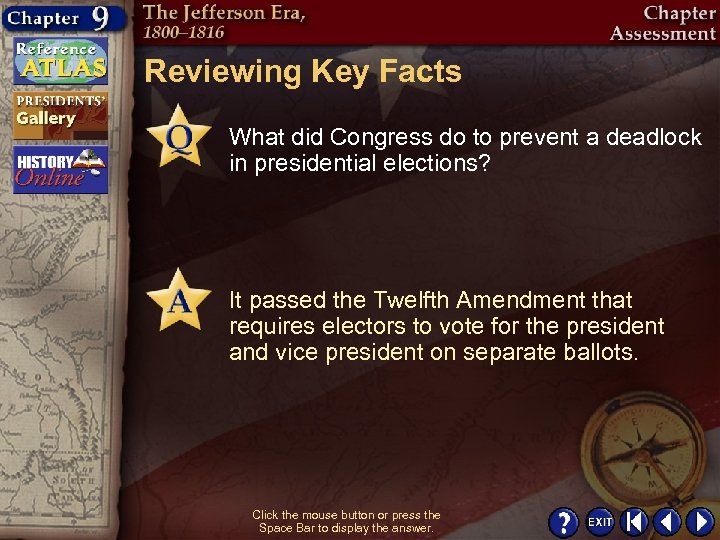
Reviewing Key Facts What did Congress do to prevent a deadlock in presidential elections? It passed the Twelfth Amendment that requires electors to vote for the president and vice president on separate ballots. Click the mouse button or press the Space Bar to display the answer.

Reviewing Key Facts How did events in Santo Domingo (Haiti) influence American expansion? The revolt in Santo Domingo was costly in terms of lives and money. The revolt was a major factor in the sale of the Louisiana Territory to the United States. Click the mouse button or press the Space Bar to display the answer.

Reviewing Key Facts How did the Embargo Act of 1807 hurt the United States? It stopped American commerce with other nations. Click the mouse button or press the Space Bar to display the answer.

Reviewing Key Facts Who were the War Hawks? The War Hawks were a group of Republicans in Congress from the South and West who urged war with Britain. Click the mouse button or press the Space Bar to display the answer.
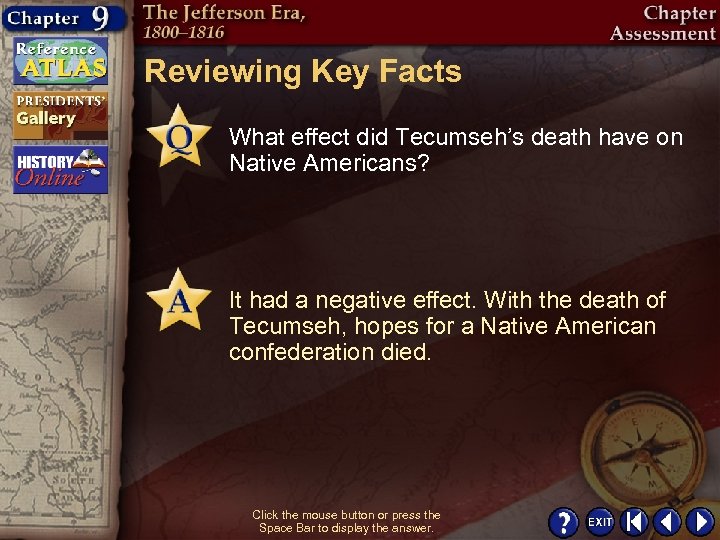
Reviewing Key Facts What effect did Tecumseh’s death have on Native Americans? It had a negative effect. With the death of Tecumseh, hopes for a Native American confederation died. Click the mouse button or press the Space Bar to display the answer.

Critical Thinking Analyzing Themes: Government and Democracy Summarize the importance of the Marbury v. Madison decision. It established the Supreme Court’s right of judicial review, in which the judiciary branch could review the acts of other branches of government. Click the mouse button or press the Space Bar to display the answer.

Critical Thinking Analyzing Information What were the boundaries of the Louisiana Territory? The boundaries of the Louisiana Territory were the Mississippi River on the east, British Canada on the north, the Oregon Country on the northwest, and Spanish territory from the southern boundary of the Oregon Country to the Gulf of Mexico west of New Orleans. Click the mouse button or press the Space Bar to display the answer.

Geography and History Activity Study the maps on the following slides and answer the questions that follow.
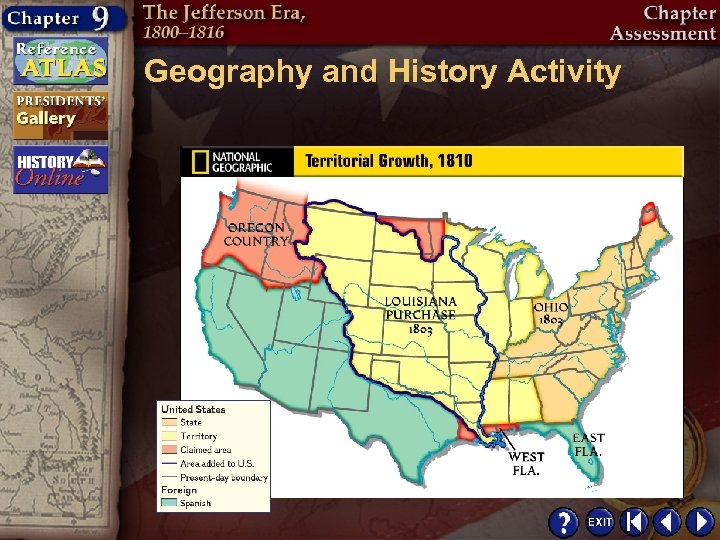
Geography and History Activity
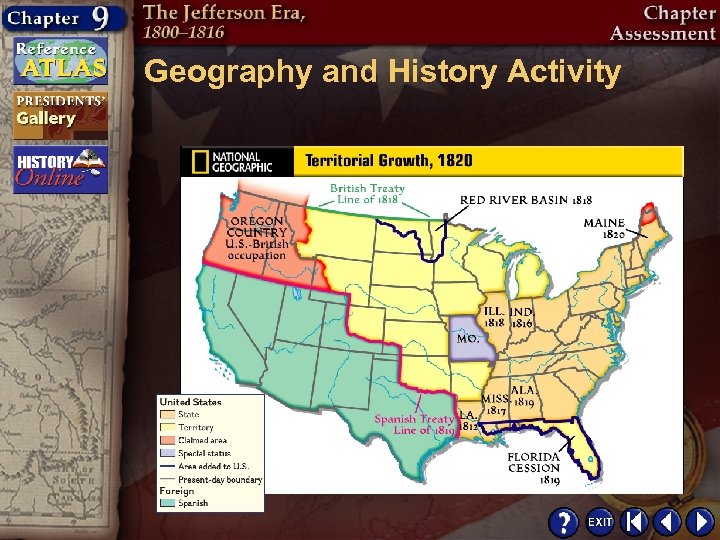
Geography and History Activity

Geography and History Activity Region What three Southern states were admitted to the nation between 1810 and 1820? Louisiana, Mississippi, and Alabama were admitted as states between 1810 and 1820. Click the mouse button or press the Space Bar to display the answer.

Geography and History Activity Location In what year did Mississippi become a state? Mississippi became a state in 1817. Click the mouse button or press the Space Bar to display the answer.
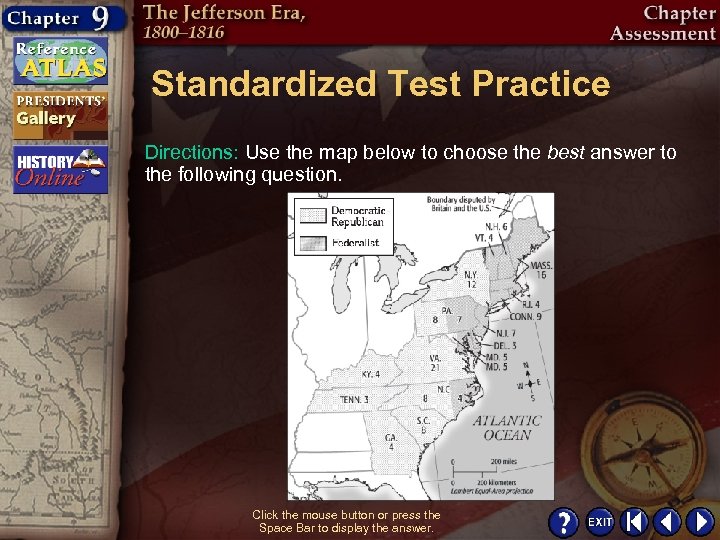
Standardized Test Practice Directions: Use the map below to choose the best answer to the following question. Click the mouse button or press the Space Bar to display the answer.
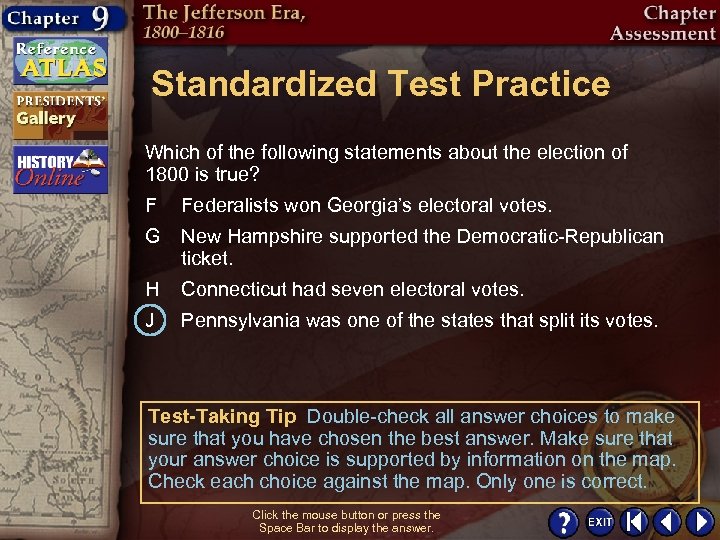
Standardized Test Practice Which of the following statements about the election of 1800 is true? F Federalists won Georgia’s electoral votes. G New Hampshire supported the Democratic-Republican ticket. H Connecticut had seven electoral votes. J Pennsylvania was one of the states that split its votes. Test-Taking Tip Double-check all answer choices to make sure that you have chosen the best answer. Make sure that your answer choice is supported by information on the map. Check each choice against the map. Only one is correct. Click the mouse button or press the Space Bar to display the answer.

As Lewis and Clark traveled down the Columbia River, they knew they were getting close to the ocean when they saw salmon in the river. Why? Salmon are an ocean-dwelling fish and travel only in freshwater to lay their eggs. Click the mouse button or press the Space Bar to display the answer.


Wagons with wooden wheels gave passengers a bumpy ride over rough terrain. When the wagons came to especially rocky stretches, people often had to get out and walk.

Embargoes Throughout its history, the United States has used the embargo as a political weapon. In 1980 President Jimmy Carter placed an embargo on the sale of American grain to the Soviet Union because the country’s troops had invaded Afghanistan. The embargo was meant to put pressure on the Soviet Union to withdraw its troops.

Uncle Sam During the War of 1812, Samuel Wilson, an army meat inspector from Troy, New York, stamped “U. S. ” for United States on the barrels of salted meat he approved. One day government inspectors asked a meat packer what the initials stood for. The worker did not know, so he said that the initials represented his boss, “Uncle Sam. ” “Uncle” Samuel Wilson soon became a symbol of the federal government.

Embargo Conestoga Tecumseh Click on a hyperlink to view the corresponding slide.

Embargo Americans enraged by the embargo made anagrams of the word embargo that reflected their anger: “O Grab Me, ” “Go Bar ‘Em, ” and “Mobrage. ” One cartoon of the time shows a snapping turtle (the embargo) clenching a merchant’s trousers in its jaws, preventing the man from loading his cargo. The merchant’s speech balloon reads, “Oh! This cursed Ograbme. ”
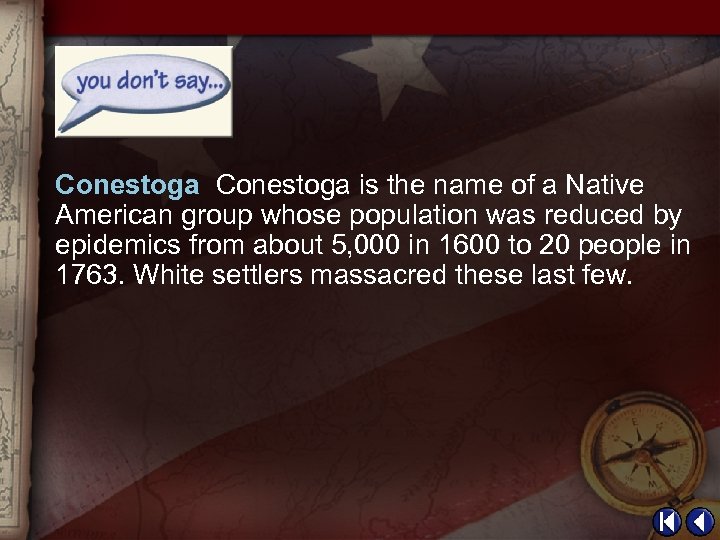
Conestoga is the name of a Native American group whose population was reduced by epidemics from about 5, 000 in 1600 to 20 people in 1763. White settlers massacred these last few.
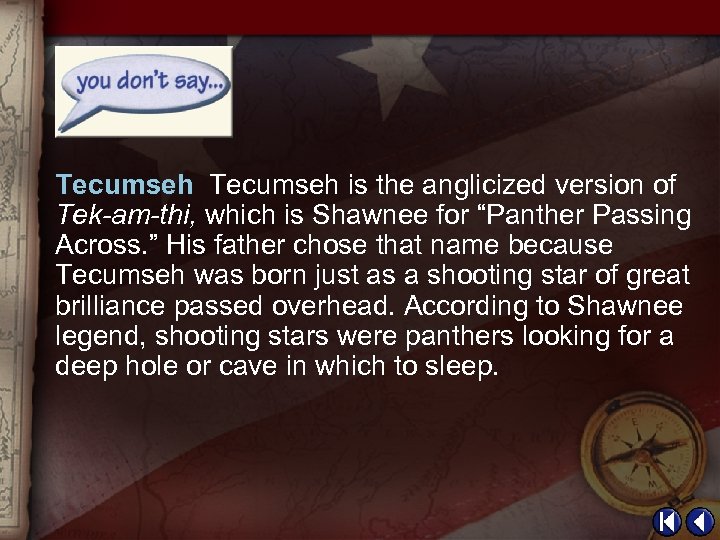
Tecumseh is the anglicized version of Tek-am-thi, which is Shawnee for “Panther Passing Across. ” His father chose that name because Tecumseh was born just as a shooting star of great brilliance passed overhead. According to Shawnee legend, shooting stars were panthers looking for a deep hole or cave in which to sleep.

The Conestoga Wagon By the mid-1700 s, sturdy Conestoga wagons transported settlers and their freight over the Appalachian Mountains. These wagons were first built in the Conestoga Creek region of Lancaster, Pennsylvania. As people pushed even farther westward, the Conestoga was seen rolling across the plains toward Oregon and California. This feature can be found on page 293 of your textbook.
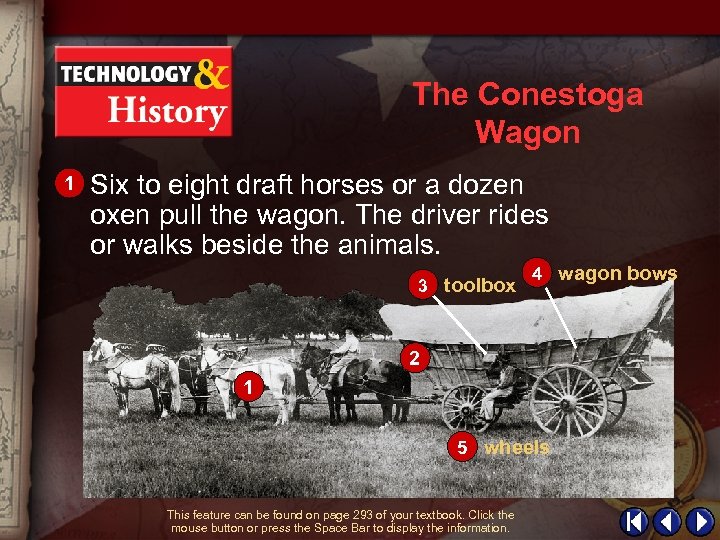
The Conestoga Wagon 1 Six to eight draft horses or a dozen oxen pull the wagon. The driver rides or walks beside the animals. 3 toolbox 4 wagon bows 2 1 5 wheels This feature can be found on page 293 of your textbook. Click the mouse button or press the Space Bar to display the information.

The Conestoga Wagon 2 The boat-shaped wagon’s high front and back keep goods from falling out on steep mountain trails. 3 toolbox 4 wagon bows 2 1 5 wheels This feature can be found on page 293 of your textbook. Click the mouse button or press the Space Bar to display the information.

The Conestoga Wagon 3 A toolbox attached to the side of the wagon holds spare parts for needed repairs. 3 toolbox 4 wagon bows 2 1 5 wheels This feature can be found on page 293 of your textbook. Click the mouse button or press the Space Bar to display the information.

The Conestoga Wagon 4 A white canvas cloth stretches over the hoops or wagon bows. This cover protects passengers and cargo from heat, rain, and snow. 3 toolbox 4 wagon bows 2 1 5 wheels This feature can be found on page 293 of your textbook. Click the mouse button or press the Space Bar to display the information.
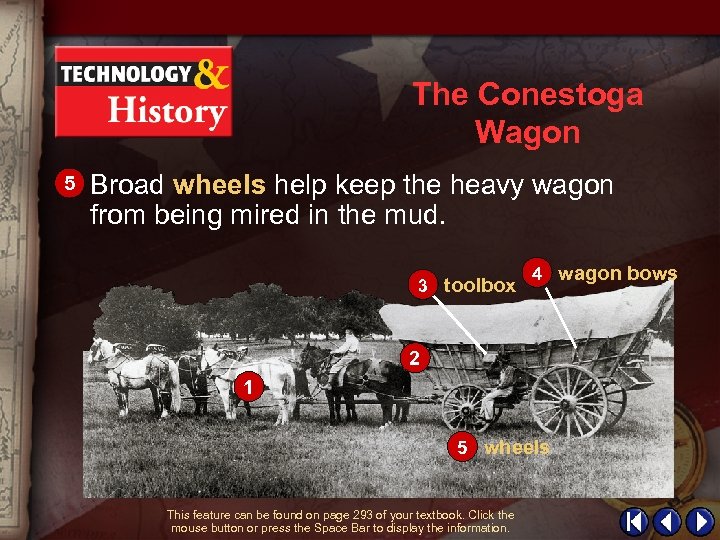
The Conestoga Wagon 5 Broad wheels help keep the heavy wagon from being mired in the mud. 3 toolbox 4 wagon bows 2 1 5 wheels This feature can be found on page 293 of your textbook. Click the mouse button or press the Space Bar to display the information.

The Conestoga Wagon The average Conestoga wagon was 21 feet long, 11 feet high, and 4 feet in width and length. It could carry up to 12, 000 pounds of cargo. 3 toolbox 4 wagon bows 2 1 5 wheels This feature can be found on page 293 of your textbook.

Writing a Journal Why Learn This Skill? Journal writing is personal writing with a casual style. What you write on is not as important as what you write about–your experiences, interests, and even your feelings. This feature can be found on page 301 of your textbook. Click the Speaker button to replay the audio.
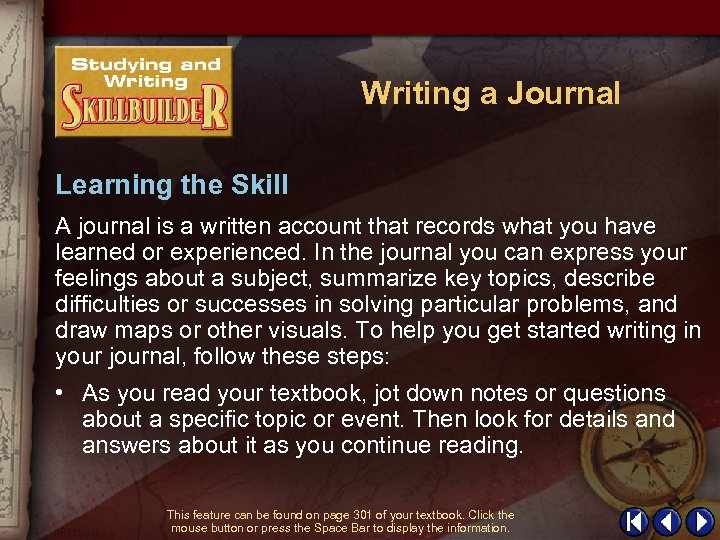
Writing a Journal Learning the Skill A journal is a written account that records what you have learned or experienced. In the journal you can express your feelings about a subject, summarize key topics, describe difficulties or successes in solving particular problems, and draw maps or other visuals. To help you get started writing in your journal, follow these steps: • As you read your textbook, jot down notes or questions about a specific topic or event. Then look for details and answers about it as you continue reading. This feature can be found on page 301 of your textbook. Click the mouse button or press the Space Bar to display the information.

Writing a Journal Learning the Skill • Describe your feelings as you read a selection or look at a photograph. Are you angry, happy, frustrated, sad? Explain why. • Ask yourself if drawing a map or flowchart would help you understand an event better. If so, draw in your journal. This feature can be found on page 301 of your textbook. Click the mouse button or press the Space Bar to display the information.

Writing a Journal Practicing the Skill The following excerpt describes the burning of Washington, D. C. , during the War of 1812. Read the excerpt, then use the following questions to help you write entries in your own journal. This feature can be found on page 301 of your textbook.
![Writing a Journal Practicing the Skill “[T]his was a night of dismay to the Writing a Journal Practicing the Skill “[T]his was a night of dismay to the](https://present5.com/presentation/d46c946367aee6ddfdff3fa0e5181349/image-162.jpg)
Writing a Journal Practicing the Skill “[T]his was a night of dismay to the inhabitants of Washington. They were taken completely by surprise. . The first impulse of course tempted them to fly. . [T]he streets were. . . crowded with soldiers and senators, men, women, and children, horses, carriages, and carts loaded with household furniture, all hastening towards a wooden bridge which crosses the Potomac. The confusion. . . was terrible, and the crowd upon the bridge was such to endanger its giving way. ” This feature can be found on page 301 of your textbook.

Writing a Journal Practicing the Skill 1. What is particularly interesting about this description? 2. What are your feelings as you read the excerpt? This feature can be found on page 301 of your textbook.
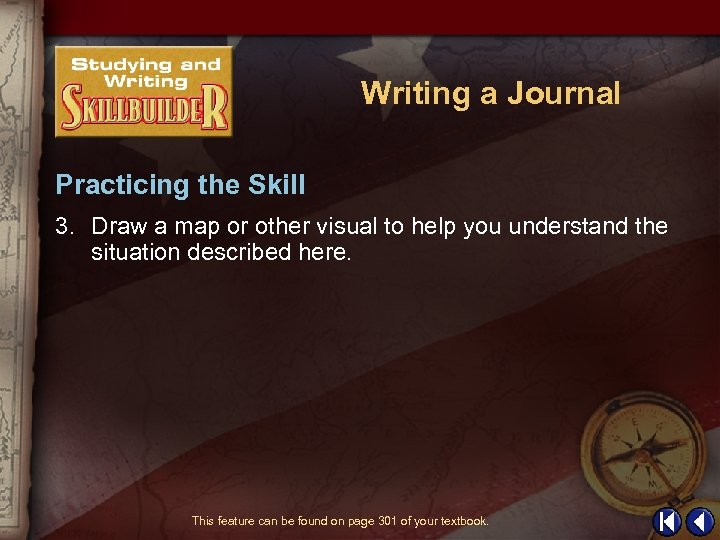
Writing a Journal Practicing the Skill 3. Draw a map or other visual to help you understand the situation described here. This feature can be found on page 301 of your textbook.
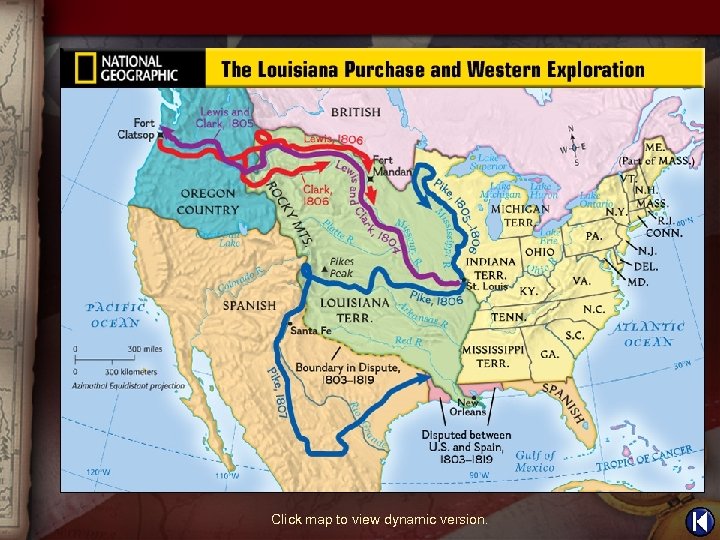
Click map to view dynamic version.

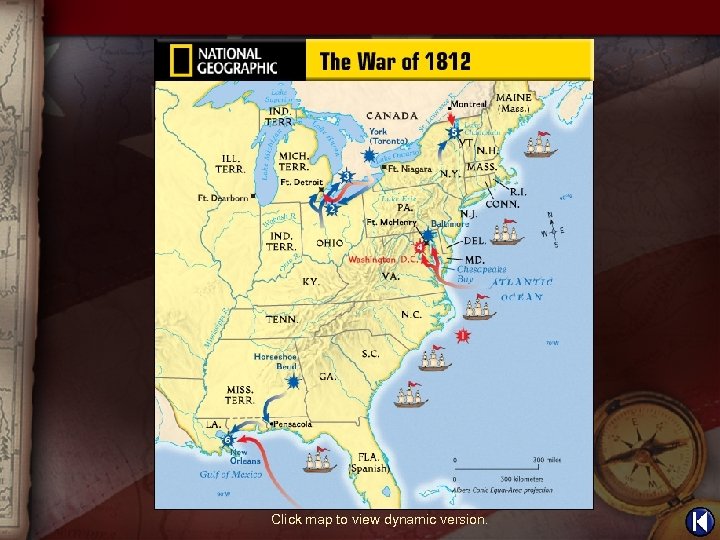
Click map to view dynamic version.





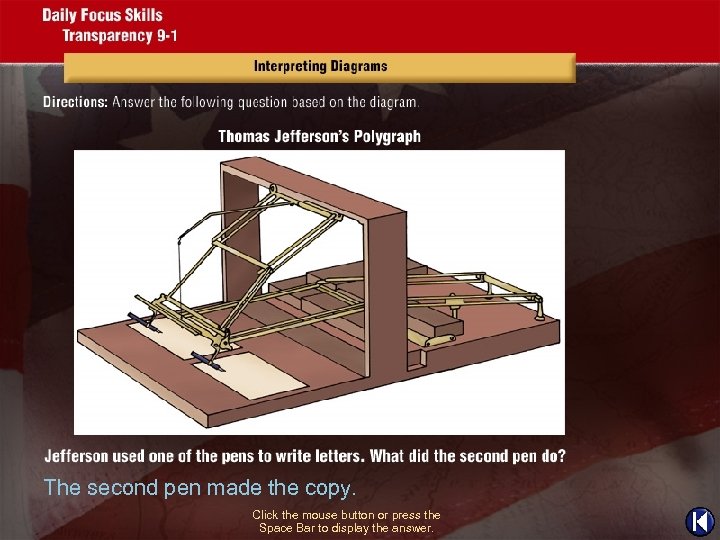
The second pen made the copy. Click the mouse button or press the Space Bar to display the answer.
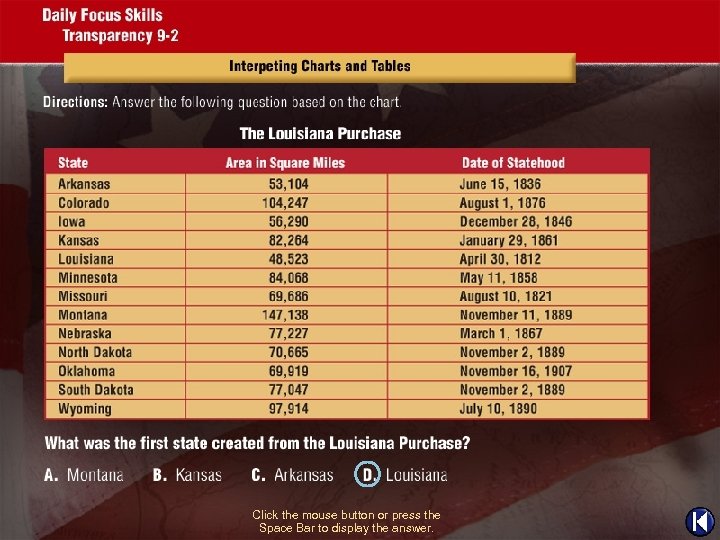
Click the mouse button or press the Space Bar to display the answer.
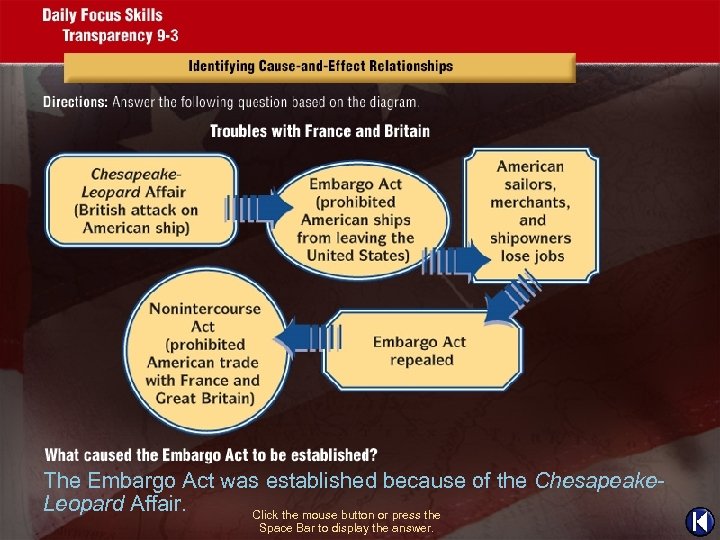
The Embargo Act was established because of the Chesapeake. Leopard Affair. Click the mouse button or press the Space Bar to display the answer.
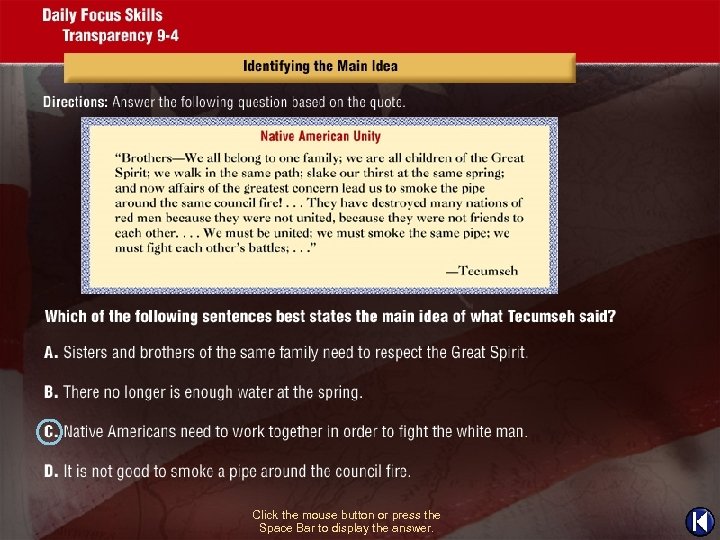
Click the mouse button or press the Space Bar to display the answer.

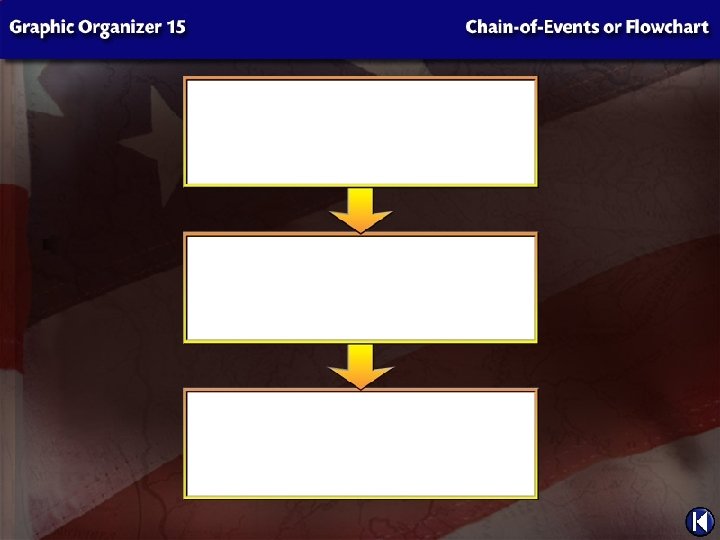

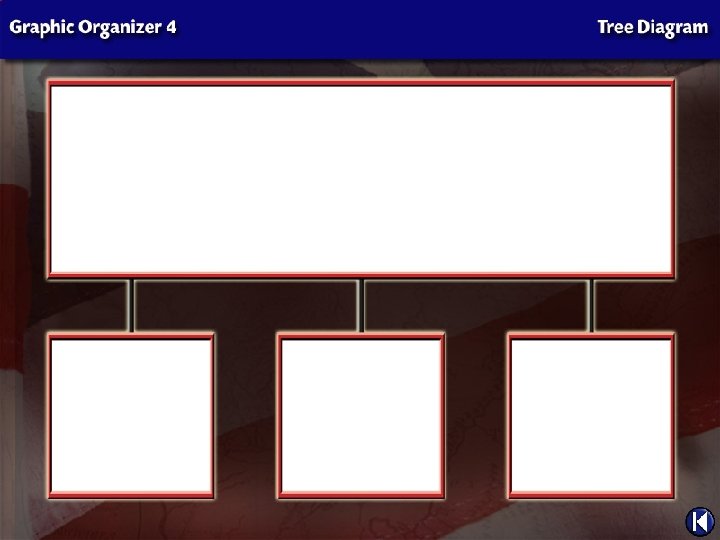
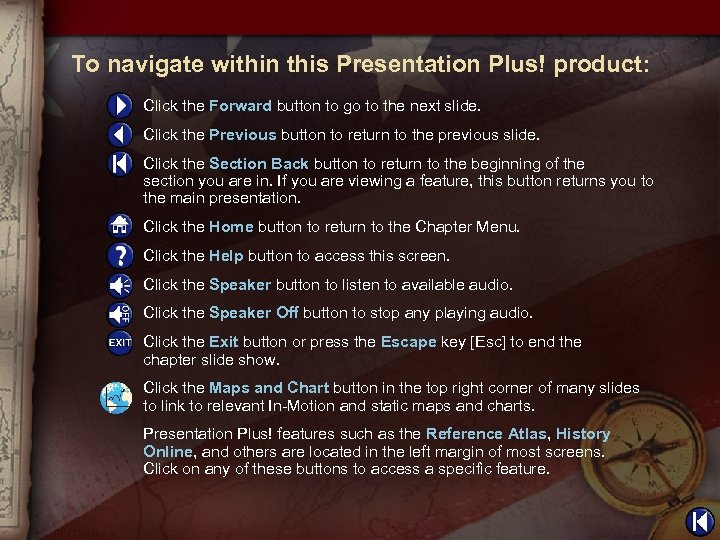
To navigate within this Presentation Plus! product: Click the Forward button to go to the next slide. Click the Previous button to return to the previous slide. Click the Section Back button to return to the beginning of the section you are in. If you are viewing a feature, this button returns you to the main presentation. Click the Home button to return to the Chapter Menu. Click the Help button to access this screen. Click the Speaker button to listen to available audio. Click the Speaker Off button to stop any playing audio. Click the Exit button or press the Escape key [Esc] to end the chapter slide show. Click the Maps and Chart button in the top right corner of many slides to link to relevant In-Motion and static maps and charts. Presentation Plus! features such as the Reference Atlas, History Online, and others are located in the left margin of most screens. Click on any of these buttons to access a specific feature.

End of Custom Shows WARNING! Do Not Remove This slide is intentionally blank and is set to auto-advance to end custom shows and return to the main presentation.

d46c946367aee6ddfdff3fa0e5181349.ppt